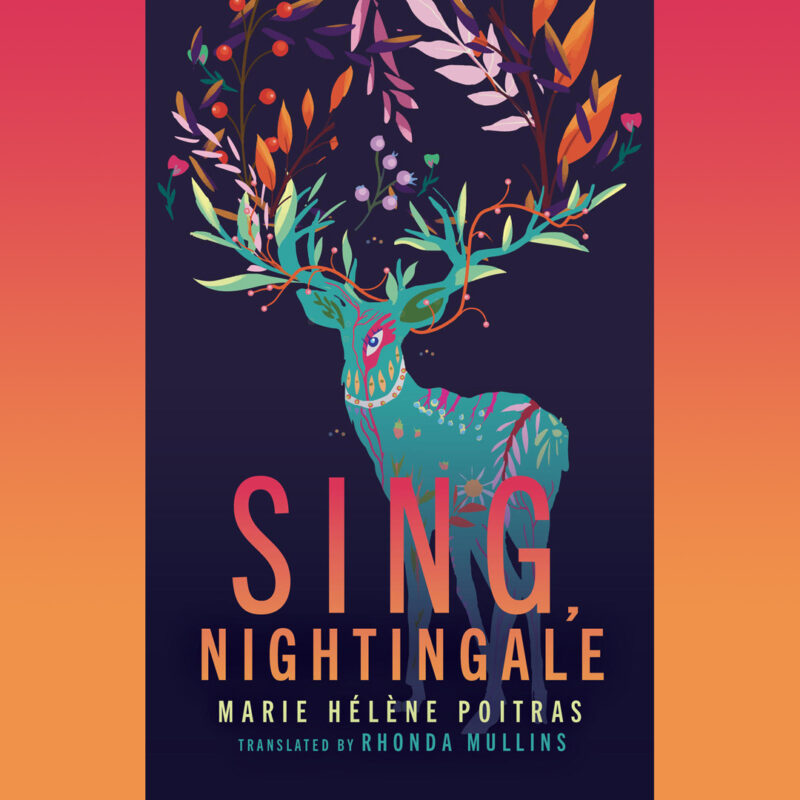USEREVIEW 118: Delight & Disconcertion
Hollay Ghadery has a fine ear for the complex orchestration of dualities in Sing, Nightingale, the latest novel by Marie Hélène Poitras, translated from the French by Rhonda Mullins (Coach House Books, 2023).
ISBN 978-1-55245-448-0 | 176 pp | $22.95 CAD — BUY Here
#CAROUSELreviews
#USEREVIEWEDNESDAY
Arguably, all books aim to transport readers to another world, but not all books can do this as self-reflexively and immersively as Sing, Nightingale by Marie Hélène Poitras (translated from the French by Rhonda Mullins). It seems a contradiction: to be able to create a world that is both meta-fictional and also so deeply immediate that one forgets that they are in a world intentionally created with the qualities of a children’s book of pop-up fairy tales: a play, with “cardboard sets, a stage on which to deliver lines, and puppets waiting on hands to bring them to life, send them scurrying right to left, until they disappear into the wings.” This is how the story begins, setting us firmly in this surreal scene, in the village of Noirax at an unspecified time in the past.
In this village is the once prosperous estate of Malmaison, which is falling into disrepair. In an attempt to bring it back its once auspicious state, “the father” — the philandering and selfish sovereign of the estate, who, in the beginning, is the character at the heart of the story — enlists the help of a young woman named Aliénor, who has promised she can bring the grounds back to their former glory.
But the tale is ripe with foreshadowing and the omniscient narrator lets us know, from almost the start, that Aliénor’s arrival will signal the end of life at Malmaison as the father knows it.
If a soothsayer had been there, he could have […] warned the father. He would have announced that someone was heading to Malmaison to sow chaos. That bad memories would be replaced by others, even worse. That this young person was already walking toward Noirax, that she was slithering like a garter snake and she had the power to awaken sap in the old trunks.
This passage not only signals future danger, but it’s also a stunning example of the narrative style used in this book. The language often dallies in the archaic (e.g. “soothsayer,” “sow chaos”) and many of the tropes are rooted in the Gothic. In fact, one of the most engrossing elements of the novel is how it both adopts and subverts Gothic tropes. There’s darkness and doubt and decay. The large, old estate home with hidden passages and looming, mysterious paintings. There’s the menacing male figure. The father is an echo of Manfred from Horace Walpole’s The Castle of Otranto (1764), which is widely regarded as the first Gothic novel.
Manfred, like the father in Sing Nightingale, is consumed with carrying on his family name. So, when a giant helmet mysteriously crushes his son Conrad on the day of Conrad’s wedding to a princess, Manfred decides he will wed her — against her will. The father in Sing, Nightingale is also a crushing sexual force, who like his forefathers, womanizes freely, resulting in many unclaimed offspring who are all women, save for one: his son, Jeanty, by his lawful (and mysteriously diseased) wife, Pampelune.
But then there’s the subversion. We learn that Jeanty is living back at home because he was thrown out of his own wife’s home for wearing his mother in law’s clothing and makeup. As the novel progresses, Jeanty slowly transforms into Jeantyelle, embracing her true identity in the face of her stupefied father. A father who has been too busy trying to seduce Aliénor and make sense of his growing feelings of impotence to truly absorb what is happening with his child.
The subverting of heteronormative notions of gender was for me, one of the most exhilarating parts of this novel. The narrator says of Jeantyelle:
Little by little, she is going to learn self-awareness, the manifestations of the physical body that must be suppressed and camouflaged as a woman, because all the magic and mystery in the world depend on the dissimulation.
Eventually, Jeantyelle flees the darkness of Malmaison, comes into herself and flourishes. But as interesting and vital as Jeantyelle’s story is, she is a secondary character in the book. It is Aliénor who eventually takes over the father’s role as the main protagonist.
He is no longer the hero of the story. He has had his turn. He went looking for a fall, charged headlong into it […] The moment has come when the protagonists have to yield place and privilege to the supporting characters.
Aliénor is far from a traditionally helpless Gothic heroine. Rather, she’s characterized as an irreverent anti-hero, effectively discarding the notion that women must be purely good or purely evil. She is “dangerous and true”; a “throbbing, blustering, probing, scrutinizing presence.”
While reading, it was impossible for me not to think of Edmund Burke’s theory of the sublime and the beautiful in the context of the Gothic novel: the sublime being what excites overwhelming terror or dread; a wild storm in a rugged landscape. Beauty, on the other hand, is what inspires love and pleasant, relaxing feelings; a dainty ankle or blushing cheek. It’s interesting to note Burke does not think beauty needs to be useful. More interesting still to consider beauty is also what he associates with femininity, leaving the formidable, fearsome sublime tied to the masculine. Seeing Poitras masterfully work against this dichotomy to topple the “helpless woman” and “strong man” trope with her rageful, unapologetic, powerful woman characters was thrilling.
Another of Poitras’ characters, Victoire — who in the father-narrated part of the story is referred to as “the harridan” (a bossy and belligerent older woman), only assuming her actual name once Aliénor takes over the tale — refuses to “use the expression ‘maiden’s blush.’ The language no longer belongs to dirty old men.” Here we are shown how Poitras subverts patriarchal values by challenging language.
Poitras further destabilizes the status quo by closely linking the wildness usually associated with the sublime / masculine to the women in her novel. “But women left so many traces in the forest,” she writes. “Aliénor could survive anywhere, rooted in any earth.” It’s this wildness that eventually puts to rights the suffocating, perverting imbalance imposed by power-hungry men.
I believe that readers will marvel at the richness and lyricism of the language in this book, which is a testament to the skill of both writer and translator. Readers will also discover a story that delights as it unnerves; is beautiful and bawdy, grotesque and gregarious — a story that allows us to slip “the yoke of reality” even as it calls into question the mores and values that tether us to it.


